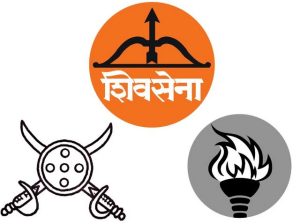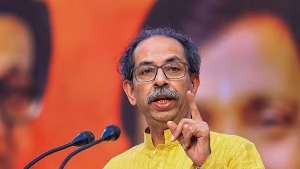The Supreme Court of India has positioned itself at the centre of Maharashtra’s most significant political controversy by scheduling crucial hearings in August regarding the Shiv Sena symbol dispute. This legal battle between two prominent political factions threatens to reshape the state’s political landscape ahead of the upcoming local body elections. The apex court’s decision will determine which faction rightfully claims the iconic “bow-and-arrow” symbol that has been synonymous with Shiv Sena for decades.
Shiv Sena symbol dispute
 Also read: https://www.newindianexpress.com/nation/2025/Jul/02/sc-questions-urgency-in-shiv-senas-plea-over-bow-and-arrow-symbol-sets-hearing-for-july-14
Also read: https://www.newindianexpress.com/nation/2025/Jul/02/sc-questions-urgency-in-shiv-senas-plea-over-bow-and-arrow-symbol-sets-hearing-for-july-14
It emerged as a contentious issue following the split within the party, creating two distinct factions led by Uddhav Thackeray and Eknath Shinde, respectively. This division has not only fractured the party’s organisational structure but has also raised fundamental questions about political legitimacy and symbol ownership in Indian democracy.
The roots of the current Shiv Sena symbol dispute trace back to the internal conflicts that plagued the party following significant political developments in Maharashtra. The party, founded by Bal Thackeray, had maintained its unity for several decades until recent political realignments created irreparable divisions between key leaders.
Uddhav Thackeray, who inherited the party leadership, found himself at odds with Eknath Shinde, a prominent leader who commanded considerable support among party legislators. This ideological and strategic disagreement eventually culminated in a formal split, with both factions claiming to represent the true spirit of the original Shiv Sena.
 The Shiv Sena symbol dispute became inevitable when both factions sought recognition from the Election Commission of India. The “bow-and-arrow” symbol, deeply embedded in the party’s identity and voter recognition, became the most contested asset in this political divorce.
The Shiv Sena symbol dispute became inevitable when both factions sought recognition from the Election Commission of India. The “bow-and-arrow” symbol, deeply embedded in the party’s identity and voter recognition, became the most contested asset in this political divorce.
The Election Commission of India’s decision to grant the “bow-and-arrow” symbol to Eknath Shinde’s faction intensified the Shiv Sena symbol dispute. This ruling came after extensive deliberations and hearings where both factions presented their cases, claiming legitimate succession to the party’s legacy and symbols.
The Commission’s decision was based on various factors, including legislative support, organisational control, and constitutional provisions governing political party recognition. However, this verdict did not settle the matter conclusively, as Uddhav Thackeray’s faction immediately challenged the decision, arguing that the Commission had exceeded its jurisdiction and misinterpreted the evidence.
 The Shiv Sena symbol dispute thus moved from the Election Commission to the Supreme Court, where constitutional experts and legal scholars are closely watching the proceedings. The case has broader implications for how political party splits are handled in India and what criteria should determine symbol allocation.
The Shiv Sena symbol dispute thus moved from the Election Commission to the Supreme Court, where constitutional experts and legal scholars are closely watching the proceedings. The case has broader implications for how political party splits are handled in India and what criteria should determine symbol allocation.
The Shiv Sena symbol dispute operates within a complex legal framework that involves constitutional provisions, Election Commission guidelines, and judicial precedents. The Supreme Court must navigate through established legal principles while considering the practical implications of its decision on democratic processes.
The Constitution of India provides the Election Commission with the power to recognise political parties and allocate symbols, but these powers are subject to judicial review. The current case tests the boundaries of the Commission’s authority and the criteria it should employ when determining legitimate party succession.
Legal experts argue that the Shiv Sena symbol dispute will set important precedents for future party splits and symbol allocation cases. The Supreme Court’s interpretation of organisational control, legislative support, and ideological continuity will influence how similar disputes are resolved in the future.
The Shiv Sena symbol dispute extends far beyond symbol allocation, fundamentally affecting Maharashtra’s political dynamics. The state, which has been governed by various coalition arrangements, faces significant uncertainty as this legal battle unfolds.
Both factions have maintained their political activities and public engagement while the dispute remains unresolved. However, the upcoming local body elections add urgency to the situation, as the symbol allocation will directly impact voter recognition and electoral performance.
The Shiv Sena symbol dispute also affects alliance politics in Maharashtra, as other political parties must decide which faction to support or align with. This decision will influence broader coalition dynamics and governance structures in the state.
The timing of the Supreme Court hearings makes the Shiv Sena symbol dispute particularly crucial for the upcoming local body elections. Local governance plays a vital role in Maharashtra’s political structure, and the symbol allocation will significantly impact how voters perceive and choose between the competing factions.
Local body elections often serve as indicators of political strength and public sentiment. The faction that secures the “bow-and-arrow” symbol will likely have an advantage in voter recognition and electoral performance, making the Supreme Court’s decision strategically important.
The Shiv Sena symbol dispute resolution will also determine campaign strategies, alliance formations, and resource allocation for the local body elections. Both factions are preparing for different scenarios while hoping for a favourable judicial outcome.
The Supreme Court’s decision in the Shiv Sena symbol dispute will have lasting implications for Maharashtra’s political future and Indian democracy more broadly. The verdict will establish important precedents for handling political party splits and symbol allocation disputes.
As August approaches, political observers and citizens alike await the Supreme Court’s ruling on this critical Shiv Sena symbol dispute. The decision will not only determine symbol ownership but will also shape the trajectory of Maharashtra’s political landscape for years to come.
The resolution of this dispute represents more than a legal victory for either faction; it embodies the broader struggle for political legitimacy and democratic representation in contemporary India. The Supreme Court’s wisdom in navigating this complex issue will influence how similar disputes are handled in the future, making this case a landmark moment in Indian political and legal history.

